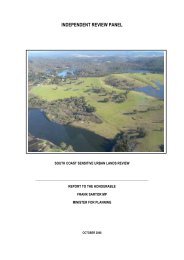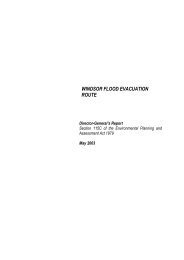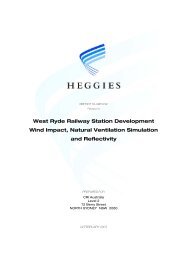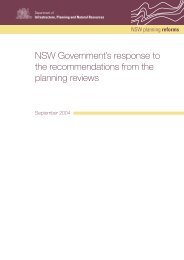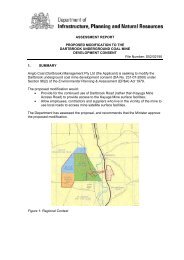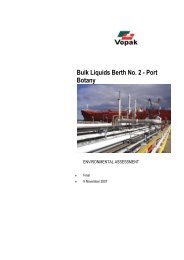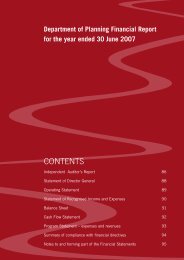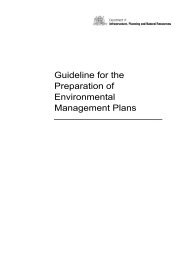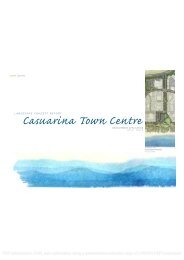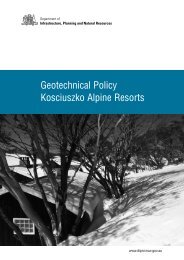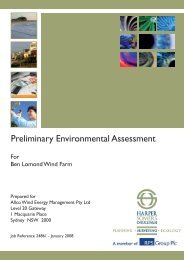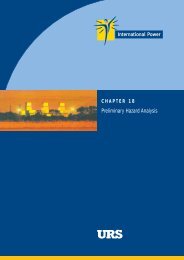Asphalt Batching Plant, Tomago - Department of Planning - NSW ...
Asphalt Batching Plant, Tomago - Department of Planning - NSW ...
Asphalt Batching Plant, Tomago - Department of Planning - NSW ...
You also want an ePaper? Increase the reach of your titles
YUMPU automatically turns print PDFs into web optimized ePapers that Google loves.
MAJOR PROJECT ASSESSMENT:<br />
<strong>Asphalt</strong> <strong>Batching</strong> <strong>Plant</strong>, <strong>Tomago</strong><br />
Director-General’s<br />
Environmental Assessment Report<br />
Section 75I <strong>of</strong> the<br />
Environmental <strong>Planning</strong> and Assessment Act 1979<br />
December 2007
<strong>Asphalt</strong> <strong>Batching</strong> <strong>Plant</strong>, <strong>Tomago</strong><br />
Director-General’s Environmental Assessment Report<br />
© Crown copyright 2007<br />
Published December 2007<br />
<strong>NSW</strong> <strong>Department</strong> <strong>of</strong> <strong>Planning</strong><br />
www.planning.nsw.gov.au<br />
Disclaimer:<br />
While every reasonable effort has been made to<br />
ensure that this document is correct at the time <strong>of</strong><br />
publication, the State <strong>of</strong> New South Wales, its agents<br />
and employees, disclaim any and all liability to any<br />
person in respect <strong>of</strong> anything or the consequences <strong>of</strong><br />
anything done or omitted to be done in reliance upon<br />
the whole or any part <strong>of</strong> this document.
<strong>Asphalt</strong> <strong>Batching</strong> <strong>Plant</strong>, <strong>Tomago</strong><br />
Director-General’s Environmental Assessment Report<br />
EXECUTIVE SUMMARY<br />
Tropic <strong>Asphalt</strong> Pty Ltd proposes to establish an asphalt plant and associated infrastructure in a new<br />
industrial area at <strong>Tomago</strong> (Lot 1 DP 589915) in the Port Stephens local government area.<br />
The asphalt plant would produce up to 150,000 tonnes <strong>of</strong> asphalt a year for the Newcastle and Port<br />
Stephens regions.<br />
It has a capital cost <strong>of</strong> $1 million and would employ 6 people during operation.<br />
The proposal is classified as a major project under Part 3A <strong>of</strong> the Environmental <strong>Planning</strong> and Assessment<br />
Act 1979 (EP&A Act) because it is a designated industrial development in the coastal zone. Consequently,<br />
the Minister is the approval authority for the project.<br />
During the exhibition period, the <strong>Department</strong> received 7 submissions on the proposal: 2 from government<br />
agencies and 5 from the general public.<br />
The <strong>Department</strong> <strong>of</strong> the Environment and Climate Change and the Roads and Traffic Authority do not object<br />
to the project, however four <strong>of</strong> the five submissions from the general public object to the project. These<br />
objections were from local residents and businesses that were concerned about the potential air quality,<br />
noise and traffic impacts <strong>of</strong> the project.<br />
The <strong>Department</strong> has assessed the merits <strong>of</strong> the project in accordance with the relevant requirements in the<br />
EP&A Act, and is satisfied that the impacts <strong>of</strong> the project can be mitigated and/or managed to ensure an<br />
acceptable level <strong>of</strong> environmental performance. It is also satisfied that the project is unlikely to have any<br />
adverse impacts on the coastal zone, as it is located in a designated industrial area and is consistent with<br />
the aims and objectives <strong>of</strong> State Environmental <strong>Planning</strong> Policy No. 71 – Coastal Protection.<br />
As the project would produce up to 150,000 tonnes <strong>of</strong> asphalt a year for the Newcastle and Port Stephens<br />
regions, attract a capital investment <strong>of</strong> $1 million and employ 6 people during operation, the <strong>Department</strong><br />
believes the project is in the public interest and should be approved subject to conditions.<br />
<strong>NSW</strong> Government<br />
<strong>Department</strong> <strong>of</strong> <strong>Planning</strong> 1
<strong>Asphalt</strong> <strong>Batching</strong> <strong>Plant</strong>, <strong>Tomago</strong><br />
Director-General’s Environmental Assessment Report<br />
1. PROPOSED DEVELOPMENT<br />
1.1 Project Description<br />
Tropic <strong>Asphalt</strong> Pty Ltd proposes to establish an asphalt plant and associated infrastructure in a new<br />
industrial subdivision ‘Hunter Industrial Park’ at <strong>Tomago</strong> (Lot 1 DP 589915) in the Port Stephens local<br />
government area.<br />
The asphalt plant would produce up to 150,000 tonnes <strong>of</strong> asphalt a year for the Newcastle and Port<br />
Stephens regions.<br />
The proposal is summarised in Table 1, depicted in Figures 2 and 3 and described in full in the<br />
Environmental Assessment (EA) in Appendix E.<br />
The site is located in new industrial subdivision <strong>of</strong>f <strong>Tomago</strong> Road, close the Pacific Highway and the<br />
<strong>Tomago</strong> Aluminium Smelter. There are some residences within 700 metres <strong>of</strong> the site, with the closest being<br />
located about 300 metres to the west <strong>of</strong> the site (see Figure 1).<br />
Figure 1: Project Location<br />
<strong>NSW</strong> Government<br />
<strong>Department</strong> <strong>of</strong> <strong>Planning</strong> 2
<strong>Asphalt</strong> <strong>Batching</strong> <strong>Plant</strong>, <strong>Tomago</strong><br />
Director-General’s Environmental Assessment Report<br />
Table 1: Major components <strong>of</strong> the project<br />
Component<br />
Project<br />
Summary<br />
<strong>Asphalt</strong> <strong>Plant</strong><br />
Associated<br />
Infrastructure<br />
Site Access<br />
Construction<br />
Hours <strong>of</strong><br />
Operation<br />
Capital Cost<br />
Employment 6<br />
Description<br />
Construction and operation <strong>of</strong> an asphalt plant and associated infrastructure to produce<br />
up to 150,000 tonnes <strong>of</strong> asphalt a year for the Newcastle and Port Stephens regions.<br />
The asphalt will be located on the south-eastern corner <strong>of</strong> the site. <strong>Asphalt</strong> would be produced<br />
by mixing aggregates, recycled asphaltic product (RAP), bitumen and fillers. These imports<br />
would be delivered to the site by trucks and stored in purpose built storage facilities.<br />
A range <strong>of</strong> associated infrastructure is required to support the asphalt plant, including:<br />
• roadworks <strong>of</strong>f Kennington Drive;<br />
• storage facilities for raw materials and LPG;<br />
• stormwater management system to retain “dirty” water on site;<br />
• fencing to secure the site; and<br />
• landscaping.<br />
Access to the site would be via two driveways to be constructed on Kennington Drive. The<br />
eastern driveway will be an entry and the western driveway will be an exit. Driveways will be<br />
designed to comply with AS2890.2 - 2002.<br />
20 weeks between 7am and 6pm Mon to Fri and 7am and 1pm Saturday.<br />
24 hours, 7 days a week.<br />
$1 million<br />
Site Access<br />
Office /<br />
laboratory<br />
Underground LPG<br />
tank<br />
Truck unloading areas<br />
Recycled asphalt<br />
storage area<br />
Tank bund<br />
Control building<br />
<strong>Asphalt</strong> plant<br />
Aggregate storage<br />
area<br />
Figure 2: Project Layout<br />
<strong>NSW</strong> Government<br />
<strong>Department</strong> <strong>of</strong> <strong>Planning</strong> 3
<strong>Asphalt</strong> <strong>Batching</strong> <strong>Plant</strong>, <strong>Tomago</strong><br />
Director-General’s Environmental Assessment Report<br />
2. STATUTORY CONTEXT<br />
Figure 3: Site Elevations<br />
2.1 Major Project<br />
The proposal is classified as a major project under Part 3A <strong>of</strong> the Environmental <strong>Planning</strong> and Assessment<br />
Act 1979 (the Act) because it meets the criteria <strong>of</strong> Clause 1 <strong>of</strong> Schedule 2 <strong>of</strong> the State Environmental<br />
<strong>Planning</strong> Policy (Major Projects) 2005, namely Clause 1(e) development for the purposes <strong>of</strong> a bitumen premix<br />
industry that is designated development and within the coastal zone.<br />
Consequently, the Minister for <strong>Planning</strong> is the approval authority for the project.<br />
2.2 Permissibility<br />
Site is zoned 4(a) Industrial (General) under the Port Stephens Local Environmental Plan 2000 (PSLEP<br />
2000) and the proposed asphalt plant is permissible with consent in this zone. Consequently, the Minister for<br />
<strong>Planning</strong> may approve the carrying out <strong>of</strong> the project.<br />
2.3 Exhibition and Notification<br />
Under Section 75H(3) <strong>of</strong> the EP&A Act, the Director-General is required to make the environmental<br />
assessment <strong>of</strong> a project publicly available for at least 30 days.<br />
After accepting the environmental assessment for the project, the <strong>Department</strong>:<br />
• made it publicly available from 14 September 2007 until 17 October 2007:<br />
o on the <strong>Department</strong>’s website, and<br />
o at the <strong>Department</strong>’s Information Centre, Port Stephen City Council, Raymond Terrace library<br />
and the Nature Conservation Council;<br />
<strong>NSW</strong> Government<br />
<strong>Department</strong> <strong>of</strong> <strong>Planning</strong> 4
<strong>Asphalt</strong> <strong>Batching</strong> <strong>Plant</strong>, <strong>Tomago</strong><br />
Director-General’s Environmental Assessment Report<br />
• notified relevant State government authorities and Port Stephen City Council by letter;<br />
• notified landowners in the vicinity <strong>of</strong> the site about the exhibition period by letter; and<br />
• advertised the exhibition in the Newcastle Herald and Port Stephens Examiner.<br />
This satisfies the requirements in Section 75H(3) <strong>of</strong> the EP&A Act.<br />
2.4 Objects <strong>of</strong> the Environmental <strong>Planning</strong> and Assessment Act 1979<br />
The Minister is required to consider the objects <strong>of</strong> the EP&A Act when he makes decisions under the Act.<br />
These objects are detailed in Section 5 <strong>of</strong> the Act, and include:<br />
‘The objects <strong>of</strong> this Act are:<br />
a) to encourage:<br />
i. the proper management, development and conservation <strong>of</strong> natural and artificial resources,<br />
including agricultural land, natural areas, forests, minerals, water, cities, towns and villages for<br />
the purpose <strong>of</strong> promoting the social and economic welfare <strong>of</strong> the community and a better<br />
environment,<br />
ii. the promotion and co-ordination <strong>of</strong> the orderly and economic use and development <strong>of</strong> land,<br />
iii. the protection, provision and co-ordination <strong>of</strong> communication and utility services,<br />
iv. the provision <strong>of</strong> land for public purposes,<br />
v. the provision and co-ordination <strong>of</strong> community services and facilities, and<br />
vi. the protection <strong>of</strong> the environment, including the protection and conservation <strong>of</strong> native animals<br />
and plants, including threatened species, populations and ecological communities, and their<br />
habitats, and<br />
vii. ecologically sustainable development, and<br />
viii. the provision and maintenance <strong>of</strong> affordable housing, and<br />
b) to promote the sharing <strong>of</strong> the responsibility for environmental planning between the different levels <strong>of</strong><br />
government in the State, and<br />
c) to provide increased opportunity for public involvement and participation in environmental planning<br />
and assessment.’<br />
The objects <strong>of</strong> most relevance to the Minister’s decision on whether or not to approve the project are found<br />
under Section 5(a)(i),(ii),(vi)&(vii).<br />
With respect to ecologically sustainable development (ESD), the EP&A Act adopts the definition in the<br />
Protection <strong>of</strong> the Environment Administration Act 1991. Section 6(2) <strong>of</strong> that Act states that ESD ‘requires the<br />
effective integration <strong>of</strong> economic and environmental considerations in decision-making processes’ and that<br />
ESD ‘can be achieved through’ the implementation <strong>of</strong> the principles and programs including the<br />
precautionary principle, the principle <strong>of</strong> inter-generational equity, the principle <strong>of</strong> conservation <strong>of</strong> biological<br />
diversity and ecological integrity, and the principle <strong>of</strong> improved valuation, pricing and incentive mechanisms.<br />
In applying the precautionary principle, public decisions should be guided by careful evaluation to avoid,<br />
wherever practicable, serious or irreversible damage to the environment and an assessment <strong>of</strong> the riskweighted<br />
consequences <strong>of</strong> various options.<br />
The <strong>Department</strong> has fully considered the objects <strong>of</strong> the EP&A Act, including the encouragement <strong>of</strong> ESD, in<br />
its assessment <strong>of</strong> the project application.<br />
The assessment undertaken by Tropic <strong>Asphalt</strong> Pty Ltd integrates all significant economic and environmental<br />
considerations and seeks to avoid any potential serious or irreversible damage to the environment.<br />
Tropic <strong>Asphalt</strong> Pty Ltd has also considered a number <strong>of</strong> alternatives to the proposed project (including the<br />
alternative <strong>of</strong> not proceeding), and considered the project in the light <strong>of</strong> the principles <strong>of</strong> ESD.<br />
2.5 Environmental <strong>Planning</strong> Instruments<br />
Under Section 75I <strong>of</strong> the EP&A Act, the Director-General’s report is required to include a copy <strong>of</strong>, or<br />
reference to, the provisions <strong>of</strong> any State Environmental <strong>Planning</strong> Policy (SEPP) that substantially govern the<br />
carrying out <strong>of</strong> the project.<br />
The <strong>Department</strong> has considered the project against the relevant provisions <strong>of</strong> several SEPPs (including<br />
SEPPs 33 and 71) and is satisfied that the proposal is generally consistent with the aims and objectives <strong>of</strong><br />
these instruments (refer to Appendix C).<br />
<strong>NSW</strong> Government<br />
<strong>Department</strong> <strong>of</strong> <strong>Planning</strong> 5
<strong>Asphalt</strong> <strong>Batching</strong> <strong>Plant</strong>, <strong>Tomago</strong><br />
Director-General’s Environmental Assessment Report<br />
2.6 Statement <strong>of</strong> Compliance<br />
Under Section 75I <strong>of</strong> the EP&A Act, the Director-General’s report is required to include a statement relating<br />
to compliance with the environmental assessment requirements with respect to the project.<br />
The <strong>Department</strong> is satisfied that the environmental assessment requirements <strong>of</strong> the project have been<br />
complied with.<br />
3. ISSUES RAISED DURING CONSULTATION<br />
During the exhibition period, the <strong>Department</strong> received a total <strong>of</strong> 7 submissions on the project:<br />
• 2 submissions from public authorities; and<br />
• 5 submissions from the general public.<br />
A summary <strong>of</strong> the issues raised in submission is provided below. A full copy <strong>of</strong> these submissions is<br />
attached in Appendix D.<br />
3.1 Public Authorities<br />
The <strong>Department</strong> <strong>of</strong> Environment and Climate Change did not object to the project, but recommended a<br />
number <strong>of</strong> conditions <strong>of</strong> approval covering:<br />
• noise and vibration management;<br />
• waste management;<br />
• dust management;<br />
• emissions monitoring;<br />
• stormwater/sediment control; and<br />
• general monitoring and reporting conditions.<br />
The Roads and Traffic Authority did not object to the project.<br />
3.2 Community<br />
Four <strong>of</strong> the five submissions from the community objected to the project. These objections were from local<br />
residents/business and primarily raised concerns about the potential air quality, noise and traffic impacts <strong>of</strong><br />
the project.<br />
The main grounds for objection from the community were (in decreasing order <strong>of</strong> priority):<br />
• Air quality – 4 <strong>of</strong> the submissions raised concerns about the amenity and health impacts associated<br />
with dust emissions from the project on people, local businesses and the environment;<br />
• Noise – 2 <strong>of</strong> the submissions raised concerns about the noise impacts on residents, and the<br />
environment; and<br />
• Traffic – 2 <strong>of</strong> the submissions raised concerns about the traffic and access impacts on surrounding<br />
businesses.<br />
Submissions also raised a number <strong>of</strong> other concerns, including visual amenity, soil and water, and land use.<br />
3.3 Response to Submissions<br />
The <strong>Department</strong> has considered the issues raised in the submissions in its assessment <strong>of</strong> the project (see<br />
Section 4).<br />
4. ASSESSMENT OF ENVIRONMENTAL IMPACTS<br />
4.1 Air Quality<br />
A detailed air quality assessment has been undertaken for the proposal. This assessment included<br />
dispersion modelling <strong>of</strong> the potential air quality impacts <strong>of</strong> the proposal against the relevant dust deposition,<br />
total suspended particulates, and PM 10 criteria.<br />
<strong>NSW</strong> Government<br />
<strong>Department</strong> <strong>of</strong> <strong>Planning</strong> 6
<strong>Asphalt</strong> <strong>Batching</strong> <strong>Plant</strong>, <strong>Tomago</strong><br />
Director-General’s Environmental Assessment Report<br />
The results <strong>of</strong> this modelling suggest that the proposal would make a very small contribution to dust levels in<br />
the surrounding area, as both transfer conveyors from the storage areas and storage areas would be closed<br />
systems, and would comply with all the relevant criteria (see Table 2).<br />
Table 2: Range <strong>of</strong> Predicted Air Quality Impacts at Closest Sensitive Receptors<br />
Pollutant<br />
Criteria<br />
Predictions - Resident<br />
1 2 3 4 5<br />
Dust Deposition (Annual) Proposal: 2 0.05 0.04 0.01 0.05 0.00<br />
2g/m 2 /month<br />
Cumulative: 4<br />
Total Suspended Particulates 90 1.32 0.92 0.30 0.47 0.00<br />
(Annual) (ug/m 3 )<br />
PM10 (Annual) (ug/m 3 ) 30 1.0 0.7 0.3 0.4 0.1<br />
PM10 (24 Hour) (ug/m 3 ) 50 5.3 4.4 2.3 3.9 2.0<br />
Nevertheless, due to the high background levels (45 ug/m 3 ), under worst case scenarios the project may<br />
contribute to some marginal exceedances <strong>of</strong> the cumulative PM 10 (24 Hour) criteria <strong>of</strong> 50 ug/m 3 on the<br />
nearest residences (see Figure 4).<br />
Figure 4: Maximum Predicted Cumulative PM10 ground level concentrations (24 Hour Average)<br />
However, it is important to note a few things about these predictions.<br />
The National Environment Protection Measure (NEPM) allows up to 5 exceedances <strong>of</strong> the PM 10 (24 Hour)<br />
criteria a year, primarily to accommodate times when background levels are high due to bushfires or some<br />
other similar events.<br />
<strong>NSW</strong> Government<br />
<strong>Department</strong> <strong>of</strong> <strong>Planning</strong> 7
<strong>Asphalt</strong> <strong>Batching</strong> <strong>Plant</strong>, <strong>Tomago</strong><br />
Director-General’s Environmental Assessment Report<br />
Tropic <strong>Asphalt</strong> Pty Ltd has predicted that on one occasion in each baseline year 1 , the maximum measured<br />
24-hour average concentration would exceed the NEPM goal <strong>of</strong> 50 ug/m 3 .<br />
Furthermore, for the proposal to cause additional exceedances, the elevated background levels would need<br />
to coincide with the proposal’s maximum output, which would cause exceedance <strong>of</strong> NEPM goal <strong>of</strong> 50 ug/m 3<br />
at residence 1 only (see Figure 4).<br />
Therefore, the <strong>Department</strong> considers that the likelihood <strong>of</strong> additional cumulative exceedances would be low.<br />
All other air emissions (e.g. heavy metals, carbon monoxide, nitrogen oxides, volatile organic compounds,<br />
etc.) would be below the relevant impact assessment criteria.<br />
The key issue raised in submissions from the general public related to the impact <strong>of</strong> dust and odour on<br />
nearby businesses. However, the <strong>Department</strong> is satisfied that the measures proposed by Tropic <strong>Asphalt</strong> Pty<br />
Ltd, including sealing <strong>of</strong> all road surfaces and keeping them free <strong>of</strong> dust, unloading the aggregate from the<br />
truck directly into a below ground hopper at a controlled rate, storing the aggregate in fully enclosed and<br />
covered overhead storage bins, cleaning the exhaust from the process heater/dryer by a fabric filter<br />
baghouse, using automatic temperature control storage tanks and use <strong>of</strong> activated carbon filters to capture<br />
volatile organic compounds and their odours would minimise air quality impacts <strong>of</strong> the project.<br />
Nevertheless, the <strong>Department</strong> believes Tropic <strong>Asphalt</strong> Pty Ltd should be required to:<br />
• comply with the stack emissions requirements under the Protection <strong>of</strong> the Environment Operations<br />
(Clean Air) Regulation 2002;<br />
• comply with the relevant criteria for pollutants, and in particular dust, particulate matter and total<br />
suspended particulate matter;<br />
• not cause <strong>of</strong>fensive odour emissions; and<br />
• commission an audit <strong>of</strong> the air emissions <strong>of</strong> the plant within 6 months <strong>of</strong> commencement <strong>of</strong> operations<br />
to ensure that it is complying with all the relevant air quality criteria.<br />
4.2 Noise<br />
4.2.1 Construction<br />
The asphalt plant would be constructed over 20 weeks during daylight hours.<br />
A construction noise assessment has been undertaken for the proposal.<br />
This assessment predicts that the construction works would only generate significant noise impacts during<br />
piling activities on site.<br />
Given that these activities are manageable, would only occur over a 2 day period and would be carried out<br />
during daylight hours, the <strong>Department</strong> is satisfied that the construction noise impacts <strong>of</strong> the proposal are<br />
acceptable.<br />
4.2.2 Operation<br />
A detailed noise assessment has been undertaken for the proposal. This assessment included noise<br />
predictions <strong>of</strong> both the potential intrusive (LAeq 15 minute) and amenity (LAeq period) impacts <strong>of</strong> the<br />
proposal. The lower <strong>of</strong> the two (i.e. intrusiveness criteria) was adopted for the noise assessment criteria,<br />
which would ensure compliance with the amenity criteria <strong>of</strong> the DECC’s Industrial Noise Policy.<br />
The results <strong>of</strong> this modelling suggest that the proposal would make a small contribution to increased noise<br />
levels during night time near residence 5 (see Figure 5) due to noise emissions from the exhaust fan. To<br />
minimise noise emission from this source, Tropic <strong>Asphalt</strong> Pty Ltd proposes to enclose this fan if subsequent<br />
monitoring indicates that the plant is not complying with noise goals.<br />
With these measures in place Tropic <strong>Asphalt</strong> Pty Ltd predicts that the treated received noise levels would be<br />
within the night time criteria for all receptors, including the residence 5 (see Table 3).<br />
1<br />
There has been no background monitoring undertaken specifically for the proposal, but data for Beresfield (located approximately 7 km<br />
west <strong>of</strong> the proposal) for years 2004-2006 from the DECC monitoring network was used.<br />
<strong>NSW</strong> Government<br />
<strong>Department</strong> <strong>of</strong> <strong>Planning</strong> 8
<strong>Asphalt</strong> <strong>Batching</strong> <strong>Plant</strong>, <strong>Tomago</strong><br />
Director-General’s Environmental Assessment Report<br />
Table 3: Predicted Noise Impacts<br />
Criteria<br />
L eq15min<br />
Daytime criteria (7am to 6pm Monday to<br />
Saturday and 8am to 6pm Sundays and Public<br />
Holidays)<br />
50.5<br />
Evening criteria (6pm to 10pm any day)<br />
51.0<br />
All other times<br />
45.0<br />
Total received noise level dB(A) L eq15min<br />
R1 R2 R3 R4 R5 R6<br />
37.8 38.0 39.7 36.5 37.5 36.3<br />
Figure 5: Sensitive noise receptors<br />
Two <strong>of</strong> the submissions from the general public raised concerns about the noise impacts on local residents,<br />
and the environment. However, the <strong>Department</strong> is satisfied that with the implementation <strong>of</strong> appropriate<br />
mitigation measures, including the construction <strong>of</strong> the exhaust fan enclosure, the proposal can comply with<br />
the relevant intrusive noise.<br />
Nevertheless, the <strong>Department</strong> believes Tropic <strong>Asphalt</strong> Pty Ltd should be required to:<br />
• comply with the project specific noise criteria; and<br />
• commission an audit <strong>of</strong> the noise emissions <strong>of</strong> the plant within 6 months <strong>of</strong> commencement <strong>of</strong><br />
operations to ensure that it is complying with all the relevant noise criteria.<br />
4.2.3 Traffic Noise<br />
A traffic noise assessment has been undertaken for the proposal.<br />
<strong>NSW</strong> Government<br />
<strong>Department</strong> <strong>of</strong> <strong>Planning</strong> 9
<strong>Asphalt</strong> <strong>Batching</strong> <strong>Plant</strong>, <strong>Tomago</strong><br />
Director-General’s Environmental Assessment Report<br />
The assessment indicates that the maximum daily output (1,500 tonnes per day) would generate up to 39<br />
truck movements and 14 car movements during evening peak hours and up to 7 light vehicles and 84 heavy<br />
vehicles in total. On a base flow on <strong>Tomago</strong> Road <strong>of</strong> approximately 9000 vehicles Annual Average Daily<br />
Traffic, or approximately 500 vehicles per hour, the additional 83 trucks per day and total <strong>of</strong> 38 vehicles per<br />
hour would be inconsequential in terms <strong>of</strong> traffic noise. The impact on potentially affected residential<br />
receptors on Punt Road would be minimal and the additional traffic flows on the Pacific Highway are even<br />
less significant than the effect on <strong>Tomago</strong> Road. Tropic <strong>Asphalt</strong> Pty Ltd has indicated that night time trucking<br />
movements would not depart via <strong>Tomago</strong> Road but would depart north along old Punt Road, thereby,<br />
avoiding night time traffic noise exposure to the residents in Old Punt Road.<br />
None <strong>of</strong> the submissions raised concerns related to noise impacts from traffic movements. The <strong>Department</strong><br />
is satisfied that the road traffic noise <strong>of</strong> the proposal is likely to be indiscernible from the existing traffic noise<br />
<strong>of</strong> the Pacific Highway and the wider regional road network.<br />
4.4 Traffic<br />
The proposal would generate about 38 vehicle movements (7 car movements and 31 truck movements) a<br />
day during peak hour normal operating conditions (see Table 4).<br />
Table 4: Predicted Trip Generation During Operations<br />
Morning Peak In 7 car trips 16 truck trips<br />
Hour Trips Out 0 car trips 15 truck trips<br />
Afternoon<br />
Peak Hour<br />
Trips<br />
In 0 car trips 15 truck trips<br />
Out 7 car trips 16 truck trips<br />
Total/day 7 car trips 84 truck trips<br />
Maximum daily output (1,500 tonnes per day) would generate up to 39 truck movements and 14 car<br />
movements during evening peak hours, in unusual circumstances. Tropic <strong>Asphalt</strong> Pty Ltd predicts that the<br />
total number <strong>of</strong> vehicles assessing the site would include 7 light vehicles and 84 heavy vehicles.<br />
These vehicles would use the existing Pacific Highway, <strong>Tomago</strong> Road and Old Punt Road to access the site.<br />
Few vehicles would use Nelson Bay Road and Cabbage Tree Road. These roads have sufficient capacity to<br />
cater for vehicles generated by the project.<br />
The junction <strong>of</strong> Old Punt Road and the Pacific Highway has been upgraded. The junction <strong>of</strong> <strong>Tomago</strong> Road<br />
and the Pacific Highway is currently under construction and works are scheduled to be completed by the end<br />
<strong>of</strong> 2007. Both <strong>of</strong> the upgraded junctions would satisfactorily cater for the additional traffic generated by the<br />
proposal. The roundabout at the intersection <strong>of</strong> Old Punt Road and <strong>Tomago</strong> Road would provide safe<br />
turning manoeuvres in all directions. The <strong>Department</strong> considers that the traffic generated by the proposal<br />
would have minimal impact on local and regional roads.<br />
The site would be accessed via Kennington Drive. The eastern driveway would be an entry and the western<br />
driveway would be an exit. The site provides sufficient room for turning movements. Eight car spaces would<br />
be provided on site including one disabled space.<br />
Nevertheless, 2 <strong>of</strong> the submissions from the general public raised concerns about the traffic and access<br />
impacts on surrounding businesses. However the <strong>Department</strong> is satisfied that the proposal would not<br />
significantly affect the level <strong>of</strong> service, capacity, vehicular and pedestrian safety <strong>of</strong> Kennington Drive and<br />
<strong>Tomago</strong> Road as the proposed site is located in the new estate, designed to cater for heavy vehicles<br />
generated by new developments in the area and the proposed site is located on a no through road which is<br />
mainly used by local business. Additionally, to ensure that vehicles generated by the project do not impact<br />
on local roads, the <strong>Department</strong>’s recommended conditions prohibit heavy vehicles associated with the<br />
project from parking and queuing on local roads in the vicinity <strong>of</strong> the site at any time.<br />
Given the above, the <strong>Department</strong> is satisfied that the traffic impacts <strong>of</strong> the proposal are likely to be minor.<br />
<strong>NSW</strong> Government<br />
<strong>Department</strong> <strong>of</strong> <strong>Planning</strong> 10
<strong>Asphalt</strong> <strong>Batching</strong> <strong>Plant</strong>, <strong>Tomago</strong><br />
Director-General’s Environmental Assessment Report<br />
4.5 Other Impacts<br />
Other issues raised during the assessment process and the <strong>Department</strong>’s consideration <strong>of</strong> the issues are<br />
summarised in Table 5 below.<br />
Table 5: Summary <strong>of</strong> Other Impacts<br />
Aspect Comment Recommendation<br />
Soil and Water<br />
• Water supply from Hunter Water<br />
Corporation.<br />
Hazards/Risks<br />
Flora and Fauna<br />
Aboriginal Heritage<br />
Waste<br />
Visual<br />
Energy and Water<br />
Efficiency<br />
• Run-<strong>of</strong>f from the site conveyed to the open<br />
earth drain to the west <strong>of</strong> the site, which<br />
drains into the Hunter River.<br />
• Potential pollution sources from dust<br />
particles, fine aggregate, hydrocarbon<br />
spills and spills from other products.<br />
• Potentially acid sulphate soils (PASS)<br />
identified onsite.<br />
• Acid Sulphate soil management plan has<br />
been prepared.<br />
• Hunter Water Corporation verbally that<br />
they had no concerns with the proposal.<br />
• Very low risk.<br />
• A preliminary risk screening was<br />
undertaken in accordance with the State<br />
Environmental <strong>Planning</strong> Policy No. 33 –<br />
Hazardous and Offensive Development,<br />
which found that the proposed project is<br />
not considered potentially hazardous<br />
and/or potentially <strong>of</strong>fensive.<br />
• Previously disturbed site with little or no<br />
habitat value.<br />
• Previously disturbed site with little or no<br />
archaeological or cultural significance.<br />
• Generate a range <strong>of</strong> regular waste<br />
(excavated material, general construction<br />
waste, domestic waste, and green waste)<br />
during construction.<br />
• Generate waste during operation including<br />
domestic waste, filler, used hydrocarbon<br />
solvents and toluene and spill absorbent<br />
material.<br />
• Proposed site part <strong>of</strong> new ‘Hunter<br />
Industrial Park’ subdivision.<br />
• Site is zoned ‘Industrial General’.<br />
• Proposed plant is featuring most up-todate<br />
technology to maximise energy<br />
efficiency.<br />
• Reuse <strong>of</strong> onsite stormwater maximised to<br />
minimise uptake <strong>of</strong> town water supply.<br />
• Implement standard erosion and<br />
sediment controls during<br />
construction.<br />
• Install a detailed stormwater<br />
management scheme during<br />
construction that is capable <strong>of</strong><br />
capturing any dirty water on site<br />
during operations, and treating it to a<br />
suitable standard.<br />
• Implement management measures<br />
outlined in the Acid Sulphate Soil<br />
Management Plan contained in the<br />
EA to manage PASS found onsite.<br />
• Store and handle all dangerous<br />
goods in accordance with all<br />
relevant Australian Standards and<br />
the DECC’s Environment Protection<br />
Manual Technical Bulletin Bunding<br />
and Spill Management.<br />
• Minimise impacts on aquatic ecology<br />
with good soil and water<br />
management.<br />
• Worimi Local Aboriginal Land<br />
Council representative to be present<br />
on site during earth moving<br />
activities.<br />
• Reuse and recycle as much <strong>of</strong><br />
construction and operation waste as<br />
possible.<br />
• Provide landscaping at the site in<br />
accordance with the Port Stephens<br />
Development Control Plan PS4.<br />
• N/A<br />
• The <strong>Department</strong> is satisfied with the<br />
measure proposed by Tropic <strong>Asphalt</strong><br />
Pty Ltd.<br />
<strong>NSW</strong> Government<br />
<strong>Department</strong> <strong>of</strong> <strong>Planning</strong> 11
<strong>Asphalt</strong> <strong>Batching</strong> <strong>Plant</strong>, <strong>Tomago</strong><br />
Director-General’s Environmental Assessment Report<br />
5. RECOMMENDED CONDITIONS<br />
The <strong>Department</strong> has prepared recommended conditions <strong>of</strong> approval for the project. These conditions are<br />
required to:<br />
• prevent, minimise, and/or <strong>of</strong>fset adverse impacts <strong>of</strong> the project;<br />
• set standards and performance measures for acceptable environmental performance;<br />
• ensure regular monitoring; and<br />
• provide for the ongoing environmental management <strong>of</strong> the project.<br />
The <strong>Department</strong> has provided the draft conditions <strong>of</strong> approval for the project to relevant government<br />
authorities for comment, and has incorporated these comments into the conditions <strong>of</strong> approval where<br />
appropriate.<br />
6. CONCLUSION<br />
The <strong>Department</strong> has assessed the merits <strong>of</strong> the project in accordance with the EP&A Act, and is satisfied<br />
that the impacts <strong>of</strong> the project can be mitigated and/or managed to ensure an acceptable level <strong>of</strong><br />
environmental performance. It is also satisfied that the project is unlikely to have any adverse impacts on the<br />
coastal zone, as it is located in a designated industrial area and is consistent with the aims and objectives <strong>of</strong><br />
State Environmental <strong>Planning</strong> Policy No. 71 – Coastal Protection.<br />
Granted the project would produce up to 150,000 tonnes <strong>of</strong> asphalt a year for the Newcastle and Port<br />
Stephens regions, attract a capital investment <strong>of</strong> $1 million and employ 6 people during operation, the<br />
<strong>Department</strong> believes the project is in the public interest and should be approved subject to conditions.<br />
7. RECOMMENDATION<br />
It is recommended that the Minister:<br />
• consider the findings and recommendations <strong>of</strong> this report;<br />
• approve the project application, subject to conditions, under section 75J <strong>of</strong> the EP&A Act; and<br />
• sign the attached project approval (see Appendix A).<br />
David Kitto<br />
Director Development Assessment<br />
Chris Wilson<br />
Executive Director<br />
Major Project Assessment<br />
Sam Haddad<br />
Director-General<br />
<strong>NSW</strong> Government<br />
<strong>Department</strong> <strong>of</strong> <strong>Planning</strong> 12
<strong>Asphalt</strong> <strong>Batching</strong> <strong>Plant</strong>, <strong>Tomago</strong><br />
Director-General’s Environmental Assessment Report<br />
APPENDIX A - RECOMMENDED CONDITIONS OF APPROVAL
<strong>Asphalt</strong> <strong>Batching</strong> <strong>Plant</strong>, <strong>Tomago</strong><br />
Director-General’s Environmental Assessment Report<br />
APPENDIX B - STATEMENT OF COMMITMENTS
<strong>Asphalt</strong> <strong>Batching</strong> <strong>Plant</strong>, <strong>Tomago</strong><br />
Director-General’s Environmental Assessment Report
<strong>Asphalt</strong> <strong>Batching</strong> <strong>Plant</strong>, <strong>Tomago</strong><br />
Director-General’s Environmental Assessment Report
<strong>Asphalt</strong> <strong>Batching</strong> <strong>Plant</strong>, <strong>Tomago</strong><br />
Director-General’s Environmental Assessment Report<br />
APPENDIX C - CONSIDERATION OF ENVIRONMENTAL<br />
PLANNING INSTRUMENTS
<strong>Asphalt</strong> <strong>Batching</strong> <strong>Plant</strong>, <strong>Tomago</strong><br />
Director-General’s Environmental Assessment Report<br />
State Environmental <strong>Planning</strong> Policy No. 33 – Hazardous and Offensive Development<br />
State Environmental <strong>Planning</strong> Policy No. 33 – Hazardous and Offensive Development applies to the site.<br />
SEPP 33 aims to identify proposed developments with the potential for significant <strong>of</strong>f-site impacts, in terms <strong>of</strong><br />
risk and/ or <strong>of</strong>fence (odour, noise etc). A development is defined as potentially hazardous and/ or potentially<br />
<strong>of</strong>fensive if, without mitigating measures in place, the development would have a significant risk and/ or<br />
<strong>of</strong>fence impact on <strong>of</strong>f-site receptors.<br />
A preliminary risk screening was undertaken in accordance with the SEPP 33, which found that the<br />
quantities and classes <strong>of</strong> hazardous materials that would be encountered on site and number <strong>of</strong> vehicle<br />
movements required to transport these materials did not reach the threshold to be classified as ‘potentially<br />
hazardous’. Therefore, the proposed project is not considered potentially hazardous and/or potentially<br />
<strong>of</strong>fensive and no preliminary hazardous analysis is required to be undertaken.<br />
The <strong>Department</strong> is satisfied with the consideration <strong>of</strong> SEPP 33 contained in the Environmental Assessment.<br />
State Environmental <strong>Planning</strong> Policy No. 55<br />
State Environmental <strong>Planning</strong> Policy No. 55 – Remediation <strong>of</strong> Land applies to the site. SEPP 55 aims to<br />
ensure that potential contamination issues are considered in the determination <strong>of</strong> a development application.<br />
Clause 7 <strong>of</strong> SEPP 55 states that:<br />
7(1) A consent authority must not consent to the carrying out <strong>of</strong> any development on land unless:<br />
(a) it has considered whether the land is contaminated, and<br />
(b) if the land is contaminated, it is satisfied that the land is suitable in its contaminated state (or will<br />
be suitable, after remediation) for the purpose for which the development is proposed to be<br />
carried out, and<br />
(c) if the land requires remediation to be made suitable for the purpose for which the development is<br />
proposed to be carried out, it is satisfied that the land will be remediated before the land is used<br />
for that purpose.<br />
The project would be located in a new industrial subdivision. The <strong>Department</strong> is satisfied that contamination<br />
is not a significant issue for this site.<br />
State Environmental <strong>Planning</strong> Policy No.71 – Coastal Protection<br />
State Environmental <strong>Planning</strong> Policy No. 71 – Coastal Protection applies to the site as it is within the coastal<br />
zone. In broad terms SEPP 71 aims to ensure that the natural, cultural, recreational and economic assets <strong>of</strong><br />
the <strong>NSW</strong> coast are protected and appropriately managed.<br />
The relevant matters for consideration in clause 8 <strong>of</strong> the SEPP 71 include:<br />
• the aims <strong>of</strong> the SEPP 71;<br />
• the suitability <strong>of</strong> development given its type, location and design and its relationship with the<br />
surrounding area;<br />
• the scenic qualities <strong>of</strong> the New South Wales coast, and means to protect and improve these qualities;<br />
• measures to conserve animals and plants, and their habitats;<br />
• measures to protect the cultural places, values, customs, beliefs and traditional knowledge <strong>of</strong><br />
Aboriginals;<br />
• likely impacts <strong>of</strong> development on the water quality <strong>of</strong> coastal waterbodies; and<br />
• the conservation and preservation <strong>of</strong> items <strong>of</strong> heritage, archaeological or historic significance.<br />
The <strong>Department</strong> is satisfied that the proposed development is broadly consistent with the aims and other<br />
matters for consideration in the SEPP 71. The <strong>Department</strong> considers that the site is suitable for the<br />
proposed asphalt plant and the project would be compatible with surrounding land uses. It would have a<br />
negligible impact on scenic qualities and water quality protection measures would ensure that adequate<br />
protection is provided for animals, plants and their habitats, including the Hunter River. The site is unlikely to<br />
contain any Aboriginal sites and does not contain other items <strong>of</strong> heritage/historic significance.
<strong>Asphalt</strong> <strong>Batching</strong> <strong>Plant</strong>, <strong>Tomago</strong><br />
Director-General’s Environmental Assessment Report<br />
APPENDIX D - SUBMISSIONS
<strong>Asphalt</strong> <strong>Batching</strong> <strong>Plant</strong>, <strong>Tomago</strong><br />
Assessment Report<br />
Director-General’s Environmental<br />
APPENDIX E - ENVIRONMENTAL ASSESSMENT



